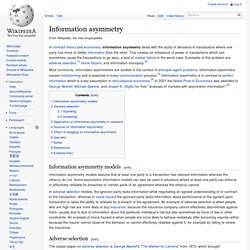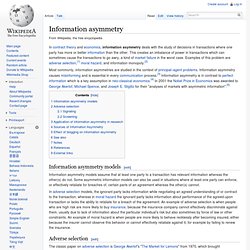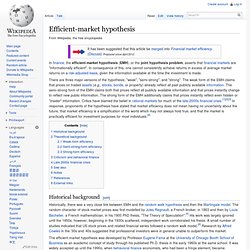

Information asymmetry. In contract theory and economics, information asymmetry deals with the study of decisions in transactions where one party has more or better information than the other.

This creates an imbalance of power in transactions which can sometimes cause the transactions to go awry, a kind of market failure in the worst case. Examples of this problem are adverse selection,[1] moral hazard, and information monopoly.[2] Most commonly, information asymmetries are studied in the context of principal–agent problems. Information asymmetry causes misinforming and is essential in every communication process.[3] Information asymmetry is in contrast to perfect information which is a key assumption in neo-classical economics.[4] In 2001 the Nobel Prize in Economics was awarded to George Akerlof, Michael Spence, and Joseph E.
Stiglitz for their "analyses of markets with asymmetric information".[5] The Market for Lemons. Akerlof's paper uses the market for used cars as an example of the problem of quality uncertainty.

It concludes that owners of good cars will not place their cars on the used car market. This is sometimes summarized as "the bad driving out the good" in the market. Thesis[edit] A used car dealer with a low-priced used car. Therefore, owners of good cars will not place their cars on the used car market. Statistical abstract of the problem[edit] A used car dealer. Suppose we can use some number. Writing the "The Market for 'Lemons'": A Personal Interpretive Essay. By George A.

Akerlof 2001 Laureate in Economics I wrote "The Market for 'Lemons,'" (a 13-page paper for which I was awarded the Prize in Economics) during my first year as assistant professor at Berkeley, in 1966-67.* "Lemons" deals with a problem as old as markets themselves. It concerns how horse traders respond to the natural question: "if he wants to sell that horse, do I really want to buy it? " Such questioning is fundamental to the market for horses and used cars, but it is also at least minimally present in every market transaction. This is a personal story. At the beginning of the 1960s, standard microeconomic theory was overwhelmingly based upon the perfectly competitive general equilibrium model. I received my Ph.D. from MIT in 1966. Growth Theory Growth theory after these two Solow articles was Galapagan, somewhere between the old economics and a new economics that has since come into being. But Solow had only made the first beachhead in what would be modern economics. 1. 2.
G Akerlof.pdf (application/pdf Object) Information asymmetry. In contract theory and economics, information asymmetry deals with the study of decisions in transactions where one party has more or better information than the other.

This creates an imbalance of power in transactions which can sometimes cause the transactions to go awry, a kind of market failure in the worst case. Examples of this problem are adverse selection,[1] moral hazard, and information monopoly.[2] Most commonly, information asymmetries are studied in the context of principal–agent problems. Information asymmetry causes misinforming and is essential in every communication process.[3] Information asymmetry is in contrast to perfect information which is a key assumption in neo-classical economics.[4] In 2001 the Nobel Prize in Economics was awarded to George Akerlof, Michael Spence, and Joseph E. Efficient-market hypothesis. In finance, the efficient-market hypothesis (EMH), or the joint hypothesis problem, asserts that financial markets are "informationally efficient".

In consequence of this, one cannot consistently achieve returns in excess of average market returns on a risk-adjusted basis, given the information available at the time the investment is made. Historical background[edit] The efficient-market hypothesis was developed by Professor Eugene Fama at the University of Chicago Booth School of Business as an academic concept of study through his published Ph.D. thesis in the early 1960s at the same school. The efficient-market hypothesis emerged as a prominent theory in the mid-1960s. Paul Samuelson had begun to circulate Bachelier's work among economists.
It has been argued that the stock market is “micro efficient” but not “macro efficient”. Theoretical background[edit] Weak-form efficiency[edit] In weak-form efficiency, future prices cannot be predicted by analyzing prices from the past.